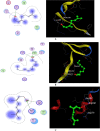Egyptian mandarin peel oil's anti-scabies potential via downregulation-of-inflammatory/immune-cross-talk: GC-MS and PPI network studies
- PMID: 37648727
- PMCID: PMC10469216
- DOI: 10.1038/s41598-023-38390-5
Egyptian mandarin peel oil's anti-scabies potential via downregulation-of-inflammatory/immune-cross-talk: GC-MS and PPI network studies
Abstract
The current study investigated the scabicidal potential of Egyptian mandarin peel oil (Citrus reticulata Blanco, F. Rutaceae) against sarcoptic mange-in-rabbits. Analysis of the oil's GC-MS identified a total of 20 compounds, accounting for 98.91% of all compounds found. Mandarin peel oil topical application improved all signs of infection, causing a scabicidal effect three days later, whereas in vitro application caused complete mite mortality one day later. In comparison to ivermectin, histopathological analysis showed that the epidermis' inflammatory-infiltration/hyperkeratosis-had disappeared. In addition to TIMP-1, the results of the mRNA gene expression analysis showed upregulation of I-CAM-1-and-KGF and downregulation of ILs-1, 6, 10, VEGF, MMP-9, and MCP-1. The scabies network was constructed and subjected to a comprehensive bioinformatic evaluation. TNF-, IL-1B, and IL-6, the top three hub protein-coding genes, have been identified as key therapeutic targets for scabies. From molecular docking data, compounds 15 and 16 acquired sufficient affinity towards the three screened proteins, particularly both possessing higher affinity towards the IL-6 receptor. Interestingly, it achieved a higher binding energy score than the ligand of the docked protein rather than displaying proper binding interactions like those of the ligand. Meanwhile, geraniol (15) showed the highest affinity towards the GST protein, suggesting its contribution to the acaricidal effect of the extract. The subsequent, MD simulations revealed that geraniol can achieve stable binding inside the binding site of both GST and IL-6. Our findings collectively revealed the scabicidal ability of mandarin peel extract for the first time, paving the way for an efficient, economical, and environmentally friendly herbal alternative for treating rabbits with Sarcoptes mange.
© 2023. Springer Nature Limited.
Conflict of interest statement
The authors declare no competing interests.
Figures













References
-
- Smith KF, Acevedo-Whitehouse K, Pedersen AB. The role of infectious diseases in biological conservation. Anim. Conserv. 2009;12:1–12.
-
- Fain A. Epidemiological problems of scabies. Int J Dermatol. 1978;17:20–30. - PubMed
-
- Currier RW, Walton SF, Currie BJ. Scabies in animals and humans: History, evolutionary perspectives, and modern clinical management. Ann. N. Y. Acad. Sci. 2011;1230:E50–E60. - PubMed
Publication types
MeSH terms
Substances
LinkOut - more resources
Full Text Sources
Medical
Research Materials
Miscellaneous

